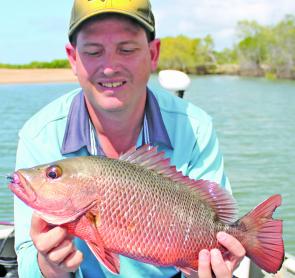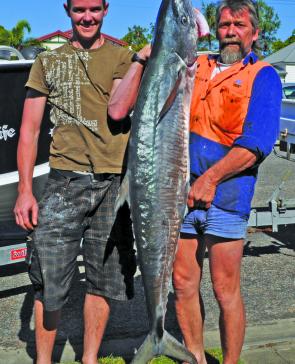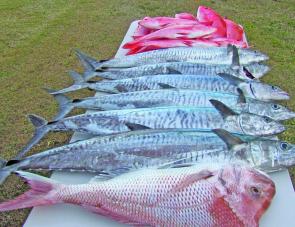September is one of those very special months of the year for anglers as it brings a mixture of both cold and warm water fish species options.
This month usually spells the end of the bitter cold and the much welcomed return of warm mild conditions and as air temps begin to rise so will water temps bringing to life many of those iconic creek species like barra and jacks, which the north is so famous for.
To say we have had a cold winter this year is a bit of an understatement as for the majority of the winter months water temps have been heavily bogged in the mid to high teens which is not very common around these parts. In fact there were more than a few days out on the water early where I had to double check the sounder as the water temperature flickered between 15ºC and 16ºC.
The quality, very rare capture of a snapper recently pulled from Bowen waters is a testament to how cold it has been here! This is the first time I have ever seen the water this cold up here and yet the creek fishing has still seen good catches of mangrove jacks and even barra for those willing to fish the warmer, shallower water.
Thankfully the cold weather will be on the back burner this month and water temps will begin to move back into the creek fisher’s favour and the fish will begin to feed more regularly and snap themselves out of that lock jaw mode.
September is a top month to target jacks and barra on soft plastics and hardbody lures. Many of the creeks will still be running clean, which a big plus as predatory fish will have more of an opportunity to see both hard and soft imitations.
While I still tend to favour slow sinking soft plastics like jerk shads and grubs this time of year, shallow suspending hardbody lures like Rapalas, Crystal Minnows, and the old faithful bomber, are also excellent choices especially when twitched and suspended around areas of structure.
One lure that has been slaying the barra and jacks over winter has been the 95mm Threadybuster and the sheer vibration of these lures seems to really get the barra (and myself) very excited. Systems like the Elliot River to the north of Bowen have already been fishing well using these techniques especially right at the top. While the creeks closer to Bowen like Boat Creek and Duck Creek have been a little slower, these systems will begin to fire up as the water warms.
The barra and jacks may be on the steady march, but the mud crabs will be doing the complete opposite, with September being one of the last months to crab consistently in the Bowen area. Don’t ask me where they go between October and December but pots tend to be full of Jenny crabs after September and finding a legal buck can be extremely difficult, so crabbers will be best to make the most of the crabs while they are still around.
The creeks north of the Don River will provide the best opportunities for those chasing a buck or two and fresh baits of either mullet or mackerel are always ideal.
Speaking of mackerel, we have had a m8ixed season so far. This can be attributed to the level of commercial activity, which has been heavily focused on the macks as the live trout fishing industry is still not producing due to Cyclone Yasi.
With stories filtering through of catches of 16 tonne of mackerel netted in one night from around the local grounds, the whole concept of mackerel netting surely must need another revisit by the powers that be? I just wonder out of all these mackerel netted how many are the legal grey macks and how many are by-catch of Spanish and Spotted Mackerel?
I understand the commercial guys need to make a living and everyone knows they are doing it tough with no government help, I just hope that when the live trout trade returns this level of netting activity declines a little. On the other hand if our government supported these guys like they did with other primary industries affected by the cyclone we may not have any issues at all.
Testament to the sheer productivity of our mackerel patches, even with so much commercial activity there have been plenty of cracker days where the spots and doggies have littered the water and the local patches have been alive with groaning red faced fishers, holding bent fishing rods with a quality silver speedster attached giving its all to stay in the blue.
While the smaller macks have been running hard, the Spanish have been a little slower. However there are still plenty being caught out wide around the outer reef, Holbourne Island, and Nares Rock, but inshore spots like the Patches and Abbott Point have been a little underdone compared to previous years catches. The quantity of Spaniards has been down a little, but the quality has not suffered with a lot of the fish pushing well over the 25kg mark and several measuring well above 40kg.
September is renowned for big Spanish especially in close around spots like North Head and the mackerel Patches as these fish have hung around the bait and smaller mackerel for months gorging themselves making them very large and very strong.
One spot that usually goes off on big Spanos in September is the Double Cone Islands just south of Glouster Island. With its massive current lines cutting across its edges this spot is best fished on neap tides even though the current will still pump around its reef edges.
Trolling big wolf herring or big lures like Hydro Magnums and Rapalas is always a great way to snare a big Spanish here but many locals have also had a lot of luck throwing stickbaits and fast retrieving stickbaits such as Koolabung Underdogs 140 and Ulua/Dogtooths. This is a lot of fun, as on most occasions the Spanish will launch fully out of the water and spear themselves onto the imitation, making for some very exciting fishing.
The latter end of this month is also the Bowen Fishing Classic which is one fishing comp you don’t want to miss. With heaps of prizes on offer including an awesome boat it is a whole weekend full of fun, family and fishing.
Next month will see an end to the pelagic fishing and more of a focus on the warmer water fish species which will be in full flight.
With only a month before the barra season closes, anglers will be best to concentrate on nailing a few big barra before they go green and become by-catch. As the early season proved to be one of the best in decades, there should be plenty of barra still around, which should make for a very exciting barra filled month.
Reads: 2276
The jack fishing will heat up in September as the water begins to warm and these fish become more aggressive.

September is big Spanish time. This 40kg plus fish taken from North Head less than 1km from Greys Bay Boat Ramp is a prime example of the quality of fish on offer. Photo courtesy of Bowen Independent

Bowen Shoals Target Species: Nannygai? Check. Spanish mackerel? Check. Snapper? What the…?! A very rare catch indeed. Photo courtesy of Mark Aitken




